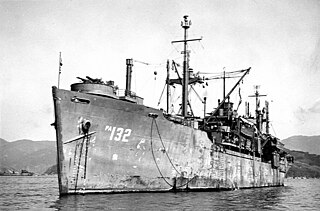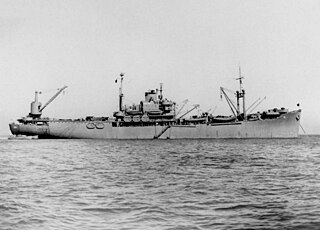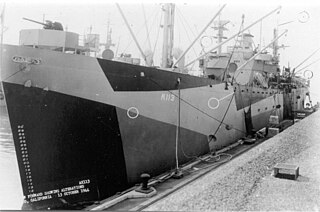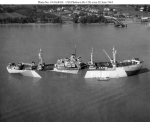
USS Altamaha (AVG-18/ACV-18/CVE-18) was an escort aircraft carrier in the United States Navy during World War II. She was named for the Altamaha River in Georgia.

USS Arided (AK-73), a Crater-class cargo ship, is the only ship of the US Navy to have this name. She was named after Arided, the other name of Deneb, the alpha star of constellation Cygnus.

The second USS Solace (AH-5) was built in 1927 as the passenger ship SS Iroquois by the Newport News Shipbuilding and Drydock Co., Newport News, Virginia. The liner was acquired by the Navy from the Clyde Mallory Steamship Line on 22 July 1940, renamed Solace (AH-5); converted into a hospital ship at the Atlantic Basin Iron Works, Brooklyn, N.Y., and was commissioned on 9 August 1941, Captain Benjamin Perlman in command.

USS De Grasse (AP-164/AK-223), originally SS Nathaniel J. Wyeth, was a Crater-class cargo ship active with the United States Navy during World War II. It was the second ship of the Navy to bear the name De Grasse, named after French Admiral François Joseph Paul de Grasse.

The USS Albireo (AK-90) was a Crater-class cargo ship in the service of the US Navy in World War II and manned by a US Coast Guard crew. She was the only ship of the Navy to have borne this name. She is named after Albireo, a star in the constellation of Cygnus.

USS Grumium (AK-112/IX-174/AVS-3) was a Crater-class cargo ship and aviation supply ship in the service of the US Navy in World War II. Named after the star Grumium in the constellation Draco, it was the only ship of the Navy to bear this name.

USS Patuxent (AO-44) was a Kennebec-class oiler in the United States Navy during World War II. She was the second U.S. Navy ship named for the Patuxent River in Maryland.
USS Saranac (AO-74), originally named the SS Cowpens, was a Type T2-SE-A1 Suamico-class fleet oiler of the United States Navy, and the fourth ship of the Navy to bear the name.

USS Barnwell (APA/LPA-132) was a Haskell-class attack transport in service with the United States Navy from 1945 to 1947. She was sunk as a target in 1986.

USS Wharton (AP-7) was a troop transport in the service of the United States Navy during World War II. The ship was originally an Emergency Fleet Corporation Design 1029 type built for the United States Shipping Board. The ship was laid down as Manmasco but renamed and launched as Sea Girt then completed September 1921 as Southern Cross. The ship was first allocated by the United States Shipping Board to the Munson Steamship Line until purchased by the line in 1925. Munson operated the Southern Cross in the South American trade from 1921 until 1938 when the ship was sold at a Marshall's sale and taken over by the United States Maritime Commission which paid the full mortgage claim.

USS Pocomoke (AV-9) was a Pocomoke-class seaplane tender, originally built as the SS Exchequer and acquired by the U.S. Navy as the military build-up occurred in the United States just prior to World War II. She operated principally in the Pacific Theatre of the war and serviced military seaplanes. At war’s end, she returned to the United States with two battle stars.

USS Arctic (AF-7) was an Arctic-class stores ship acquired by the United States Navy shortly after World War I, which saw extensive service in World War II. She served in the Pacific Ocean, delivering food and household items to ships and bases.

USS Auriga (AK-98) was an Auriga-class cargo ship, the only ship in her class, commissioned by the U.S. Navy for service in World War II, named after the constellation Auriga. She was responsible for delivering troops, goods and equipment to locations in the war zone.

USS Rutilicus (AK-113) was a Crater-class cargo ship commissioned by the US Navy for service in World War II. She was responsible for delivering troops, goods and equipment to locations in the Asiatic-Pacific Theater.
USS Alderamin (AK-116) was a Crater-class cargo ship commissioned by the U.S. Navy for service in World War II, named after Alderamin, the alpha star in constellation Cepheus. She was responsible for delivering troops, goods and equipment to locations in the war zone.
USS Zaurak (AK-117) was a Crater-class cargo ship commissioned by the U.S. Navy for service in World War II. She was responsible for delivering troops, goods and equipment to locations in the war zone.

USS Phobos (AK-129) was a Crater-class cargo ship commissioned by the U.S. Navy for service in World War II. She was responsible for delivering troops, goods and equipment to locations in the war zone.

USS Ascella (AK-137) was a Crater-class cargo ship commissioned by the US Navy for service in World War II. Ascella was named after Ascella, a star in the constellation Sagittarius. She was responsible for delivering troops, goods and equipment to locations in the Asiatic-Pacific Theater.
USS Volans (AKS-9) was an Acubens-class general stores issue ship commissioned by the U.S. Navy for service in World War II. She was responsible for delivering and disbursing goods and equipment to locations in the war zone.
USS Wateree (ATA-174), the third ship named USS Wateree, was a Sotoyomo-class auxiliary fleet tug in the service of the United States Navy during World War II. She later served with the Military Sea Transportation Service and the Peruvian Navy as a diving support ship. In Peruvian naval service she was renamed BAP Unanue (ATA-136).














